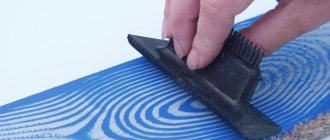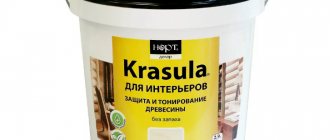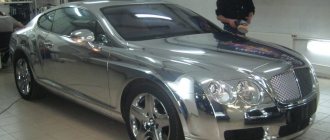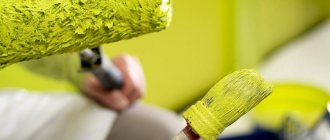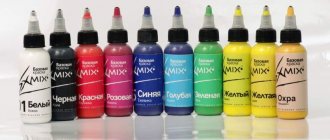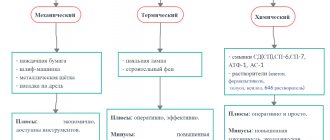How to remove paint from wood mechanically
In the mechanical method, abrasive materials are used that remove the paint layer from the surface with grain. Small items can be cleaned of paint by hand; for large surfaces it is better to stock up on an electric tool. Items of complex configuration with numerous joints and recesses are difficult to clean mechanically.
Sandpaper
You can remove paint from a small wooden part using sandpaper. First, take a sandpaper with a large grain; you can use it to remove the main part of the coating. Fine-grit sandpaper is then used to remove any remaining paint and sand the wood.
Expert opinion
Zakharova Irina Yurievna
Cleaning professional with 15 years of experience. Our best expert.
Ask a Question
For ease of work, the block is wrapped in paper. This method is considered to be the most cost-effective and harmless to the part, since the pressure is controlled, the wood remains without scratches, and the part remains without damage.
Drill
Sanding attachments are put on the drill and the paint layer is removed at low speeds. The advantages of the method are speed. The pressure of the tool is strictly controlled so as not to damage the wood. You need to wear goggles and a respirator to work, as paint particles and dust fly in all directions.
Using an angle grinder
A flap emery disc is put on the angle grinder, the device operates at low speeds. The part is placed in a horizontal plane, the machine is held with both hands. Work carefully so as not to remove part of the wooden base along with the paint. The circle is regularly replaced as it becomes clogged with crumbs. The finishing process is carried out with sandpaper, sweep away the dust, and wipe with a damp cloth.
See also
The best brands of heat-resistant paint for calipers and how to apply it yourself
Iron brush
Cord brushes consist of metal wire, which quickly removes the paint layer. Using a hand iron brush, you can remove paint from hard-to-reach places, corners, and joints that are difficult to reach with an electric tool or simple sandpaper. Using a cord brush can seriously damage the wood; you need to work carefully, controlling the pressure.
Help: When mechanically removing paint, several tools are usually used.
Methods for removing old coating from wood
The durability and quality of repairs directly depends on the preparation of the base. Of course, you can apply a new coating over the old one, but the appearance of such a finish will be far from ideal, and the durability of the coating remains a big question. Therefore, so that the time spent on repairs and money on materials are not wasted, it is necessary to remove the old paintwork.
There are several ways to perform this procedure:
- Mechanical;
- Thermal;
- Chemical.
To make it clearer what the advantages of washing are, let’s briefly consider the features of these methods.
Removing paint with sandpaper
Mechanical
The oldest and most famous is the mechanical method. As a rule, there is no alternative to it in small areas. It is done with your own hands using a sharp tool or sandpaper. With a lot of effort, after some time you can get an acceptable result. .
If you need to clear a large area of old finishing, you will have to use a power tool, for example, a grinder or a drill with a special attachment. This work takes a lot of time and effort, and it is not always possible to achieve the desired result.
Another serious disadvantage of this type of paint removal is the high likelihood of damage to the wood surface.
Removing paint using a hair dryer
Thermal
A much more technologically advanced method is the thermal method. Previously, irons were used for these purposes, which heated paint through foil, and blowtorches. In our time, construction hair dryers have appeared, which have greatly simplified this procedure. .
The essence of this method is that the paint is heated to a high temperature, after which it softens and swells. After this, it can be easily removed with a scraper or brush.
This method is more effective and not as dusty as the mechanical one, however, it is not always possible to use it. In addition, you will need a professional-grade hair dryer, which not everyone has.
In the photo - applying the wash
Chemical
Not so long ago, this method was ineffective and quite dangerous. As a rule, it consisted of using solvents corresponding to the type of painted surface. In addition, there are folk recipes that contain dangerous acids or alkalis .
However, all these products, in addition to being toxic, are ineffective in removing multi-layer coatings. In addition, solvents quickly begin to evaporate, reducing the effectiveness of this method to zero and saturating everything around with toxic fumes.
The situation has changed dramatically with the advent of special removers, which loosen old paint and make it extremely easy to remove mechanically. The main advantage of the remover is the ability to remove paint without damaging the surface of the wood.
Thermal methods for removing old paint
When heated, the paint layer swells and cracks, and the coating is easily removed with a scraper. This method is used for products that have been painted many times. The main difficulties of the thermal method:
- high temperatures are dangerous for hands and wood - you can dry out or burn the wood (over an open fire);
- if the product is complex, you can damage other materials, in particular, melt plastic, damage wiring in the walls;
- toxic substances are released from the paint.
At high temperatures, the dye leaves the wood, the surface becomes clean, suitable for new processing in any way.
Gas-burner
This method is dangerous due to open flame; it must be used carefully to prevent the wood and paint from igniting. The result is often not satisfactory - the wood is deformed and resins are released.
Construction hair dryer
Using a heat gun helps create high temperatures without the risk of fire. The hot air gun is held in one hand 5 centimeters from the coating, and the peeling paint is immediately removed with the other. Hot air guns have different attachments and the temperature is adjustable. When working, you need to protect your hands from burns and protect areas of the surface for which heating is undesirable.
Washing and its features
Removers are special chemical compounds that are designed to remove various paint and varnish coatings. The principle of their action is that the product is absorbed into the paint, while softening it and, as it were, foaming.
Note! Before purchasing a remover, you need to make sure that it is intended for removing paint from a wooden surface.
All modern paint removers are high-tech products that contain aggressive chemicals. They are able to interact with paint without causing harm to the surface of the product.
Universal remover
It must be said that many types of compositions are narrowly targeted, i.e. intended for certain types of paint and varnish coatings. However, you can also find universal products on sale that are suitable for removing different types of finishing varnishes and paints.
In particular, such compositions do an excellent job with oil-based, alkyd, pentaphthalic, nitrocellulose, polyurethane or even epoxy-based coatings. They are effective even when removing multi-layer varnish coatings.
Thanks to its gel-like consistency, the remover does not run off vertical surfaces, which makes it easy to use. As for the disadvantages of this method, in addition to toxicity, the disadvantage is the high price of the product. However, it is justified by the high speed of removing old paint - at a time, washing can remove up to ten layers of old coating.
Note! When working with the remover, it is forbidden to use plastic tools, as they may melt.
Removing dust and dirt before removing varnish
Using a remover to remove paint from a wooden surface
A remover is a chemical reagent that dissolves dyes. After applying the composition to the surface, the paint layer swells, the paint loses its adhesive properties, and moves away from the surface of the wood. The wood becomes clean, smooth and even. Due to the absence of mechanical impact, friction, there are no wounds, chips, or scratches on the surface that worsen the appearance of the products.
Removers are convenient for removing dye from a small area - they can be applied locally to a separate area (gel formulations). A large product (for example, a window frame, a door) can be treated with a chemical without removing it from its hinges. Liquid remover can be used to easily remove paint from a product with a complex configuration (furniture).
The washes are easy to use and do not require work skills, physical effort or special tools.
Types of compositions
The industry produces an impressive range of paints on different bases. Accordingly, washes are produced that have the following properties:
- Universal. Dissolves any types of dyes. This option is intended for cases where it is not known what type of paintwork is applied to the tree. Universal-purpose removers are cheaper than specialized ones, but dissolving paintwork materials will require more time and the amount of reagent. They act more slowly and sometimes the product requires re-processing. Advantages - you don’t have to worry about whether you got the base right; if necessary, you can remove the paint from another product.
- Specialized. The basis of the drug is a specific type of solvent intended for the base of a certain composition. These products are more expensive, but they quickly remove paint from wood. They produce compositions for removing the following dyes - polyurethane, alkyd, epoxy, and others.
See also
Master classes on drawings on stones for beginners step by step, painting ideas
Removers also differ in release form - liquid, dry powder, gel. Dry wash is diluted before use.
How to choose the right one
When choosing the type of wash, consider the following points:
- You should choose special products for wood - they do not have a negative effect on the wood and do not deform the surface.
- Liquid compositions are suitable for wooden products with carvings and complex shapes. The liquid penetrates into corners, gaps, and dissolves the paint over the entire surface.
- Gel washes do not run off and adhere firmly even to vertical products. They are convenient for removing paintwork from doors and frames.
- If the paint base is known, it is better to remove it with a specialized product designed for this type of dye.
When working with veneer furniture, experts recommend giving preference to products that can be removed with white spirit so as not to damage the wood. When choosing, you need to read the instructions - substances may have restrictions on conditions of use and temperature limits for use.
Operating Instructions
It is recommended to use the wash according to the following scheme:
- Surface preparation stage. The product is cleaned of dirt, dust, and washed. Wipe and dry.
- All parts of the item that do not need to be cleaned of paint are securely covered with film.
- The composition is applied with a hard brush, roller or by immersion in the solution. Gel removers are distributed carefully over the surface. Leave for 5-60 minutes (as recommended by the instructions). The composition should not be kept on the tree for longer than the specified period.
- After swelling, the paint layer should be removed with a tool. If the dye does not come off, apply the remover a second time. Use a scraper for flat parts, a scraper and a mesh sponge for carved and figured objects. Oak parts are treated with a sponge with an abrasive layer.
- The tool is moved along the wood fibers.
- After removing the paint layer, wipe the entire part with white spirit. This will neutralize the remover and help prevent the solvent from affecting the wood.
- Then wash with warm soapy water to remove any remaining fatty components.
See also
Do-it-yourself MDF painting technology and types of compositions, how to choose
Before priming and repainting, the products are thoroughly dried.
Important: after removing the paint, wash the wooden parts in accordance with the instructions; do not allow the wash to dry on the products.
Types of washes
The specialized market is dominated by universal compositions - they are usually chosen by beginners who doubt the essence of the old coating that they have to get rid of. Specialized removers work more “targetedly”, allowing you to dissolve specific types of paintwork without residue.
Universal substances
They are relevant if the type of original coating is not known; they are also in demand due to their reasonable cost - this is a convenient solution for a limited budget. They cannot boast of high efficiency, since removing the old layer will require more effort and time. Solvents, which are invariably present in the composition, quickly evaporate, as a result of which the consumption of the chemical cocktail increases.
Universal liquid remover for wood
Specialized removers
The principle of operation of all variations is the same: substances actively interact with the coating, so the latter is destroyed. The compositions of paints can have fundamental differences, so it is advisable to use narrow-profile solvents that have a targeted effect. You can find mixtures that eliminate the following types of paints:
- alkyd,
- polyurethane,
- nitrocellulose;
- oil;
- epoxy;
- pentaphthalic.
All of them are effective and have a fast effect.
Alternative removal methods
You can remove the paint layer from wood using traditional methods if you don’t have a ready-made remover. These methods are also classified as chemical - the substances used soften the dye and cause a weakening of the adhesive properties.
Caustic soda solution
Caustic soda is used to remove paintwork as follows:
- soda is diluted in water;
- apply the composition to the paint layer - for 1-2 hours;
- using a scraper, remove the swollen paint;
- If necessary, apply caustic soda again.
The product is washed with warm soapy water, then with clean water. When processing vertical parts, the solution is thickened with oatmeal so that it does not drip. Flour is added if the dye layer is large and old. In this case, it may take several hours for the paint to dissolve.
Bleaching powder
Bleach is dissolved in water and a layer of paint and varnish is covered with the solution. When the paint begins to come off, remove it with a steel wool or scraper. Bleach additionally helps to discolor stains on wood, kills fungus, and removes mold. A bleach solution is used after ready-made washes to disinfect old wooden products.
Surface preparation
Before applying stripper or paste to wood, it is important to properly prepare the surface. The preparatory activities include the following steps:
- Any contaminants, including dust, debris and dirt, are removed from the tree;
- all surrounding objects and products are protected with cellophane film so that the remover does not get on them;
- The wood is thoroughly wiped, it must be dry and clean.
Safety regulations
When working with any cleaning solution, including Docker wood, it is important to follow safety precautions:
- the wash must be applied using personal protective equipment, such as gloves, a respirator, goggles, thick protective clothing, an apron;
- If a chemical comes into contact with a person's skin or eyes, the affected area should be immediately washed with a large volume of tap water. If there are traces of a chemical burn on your skin, be sure to consult a doctor.
